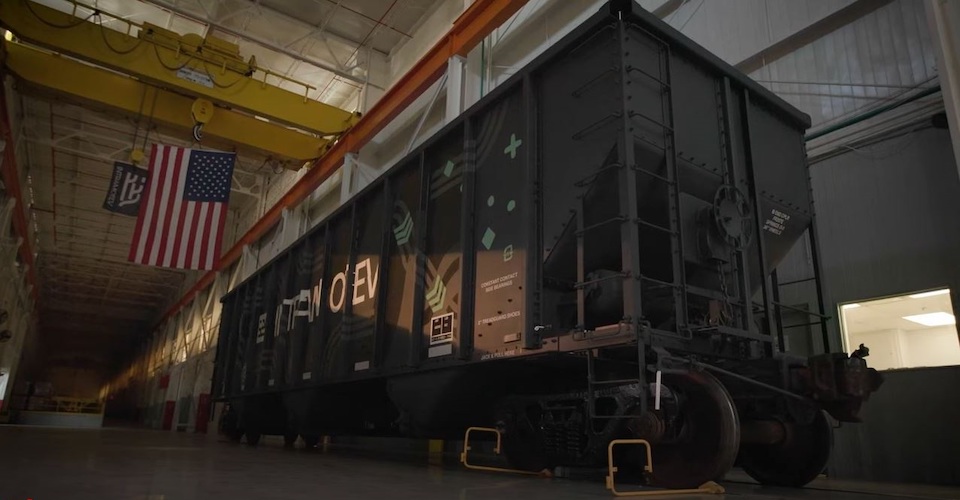The commercial launch progress of Intramotev Autonomous Rail’s autonomous, zero-emission railcar was highlighted during the opening session of FreightWeekSTL 2023, which kicked off May 22. This new railcar that would operate without the use of a locomotive has the potential to make the U.S rail system more efficient and sustainable, while also enhancing safety on the nation’s 140,000-mile rail freight network. It is one of the emerging technologies featured during FreightWeekSTL’s Innovation Day, which highlighted several companies with the potential to dramatically change the future movement of freight.
Launched in January 2020, Intramotev has been focused on the development of its primary product -- the TugVolt, a battery electric self-propelled rail car that enables freight to move with the flexibility of a truck, without breaking the existing model of rail operations.
With the rail network currently operating with as little as a 3% utilization, Luchini said the rail industry is uniquely suited to be able to grow its market share and increase the 700 billion dollars worth of goods that are moving across the country via North American rail. He also believes the solution his company is bringing to the market can help drive that growth and is excited with the advances Intramotev is making toward demonstrating how to get that utilization factor up, keep materials moving and, and better utilize existing assets.
In the last year alone, Intramotev has grown by 20 employees. It now has two operating facilities – including its original location in Granite City, Ill., and a new headquarters in St. Louis, Mo., which opened 20,000 square-feet of space for further growth and the ability to produce and test the rail cars it is building. An additional round of financing has also been secured, and Luchini said those resources are being used to accelerate the development of its primary product and get it into customer hands, along with a couple of other differentiated products.

Building on the success the company had in 2022 securing Letters of Intent (LOIs) and engagement from customers using commercial demonstration test bed units for TugVolt, the company now has converted that into what Luchini refers to as the Minimum Viable Product (MVP.) Intramotev intends to deploy multiple vehicles and product variants to customers this year. These rail vehicles are being used for point-to-point moves where the rail is not interchange connected and is considered insular by the Federal Railroad Administration. Customers are seeing anywhere from 30 to 80 percent reduction in operating expenses and better use of currently owned, onsite assets. While the company continues to focus on captive private insular rail use cases like mines, ports and interplant materials moves, it is also looking to the broader rail industry as it proves its safety and reliability in captive use cases.
Making the transition to networks that are interchange connected requires a regulatory change, so Intramotev is collaborating with federal regulators to go through the waiver process to get its vehicles onto routes that can be interchange connected. The company also will be working to grow future deployments and build out local relationships up and down the Mississippi River.
“The industry is pretty open to new technology and what we are bringing to the market,” said Luchini. “We can step into those routes being used as a railcar as well as this independent mode of power that the TugVolt product offers, giving both the ability to complement a traditional, long train going across the country, enabling a short consist and then enabling independent point-to-point movement as well.” He added their solution provides a strong means for improving safety and reliability of systems, as well as tremendous environmental benefits.
“If we can move as little as 1% of truck ton miles to TugVolts, that's going to be 4.4 million metric tons of CO2 eliminated on an annual basis. That is huge.”
Elaborating specifically on the role Intramotev’s solutions can play in enhancing rail safety, he called attention to the TugVolt’s shorter stopping distance where you can get to starting and stopping more on the order magnitude of a truck. Looking at something going 20 miles an hour, he said you might be able to stop in as little as four car lengths with the traditional braking systems as well as the TugVolt electric braking systems, something a traditional train could never do. Luchini also thinks enabling smaller trains and having sensors on individual cars that can dynamically give feedback can support a safer environment on the rail network.
Mary Lamie, Executive Vice President of Multi Modal Enterprises for Bi-State Development and head of the St. Louis Regional Freightway, moderated the conversation with Luchini. “It's great to hear that the Federal Railroad Administration is being forward thinking and technology focused as you continue to advance this initiative, and also that the rail industry as a whole is open to the potential advantages your new vehicles could deliver,” said Lamie. “We're excited that you're based here in the St. Louis region and eager to see your continued progress as you work to deliver solutions that will give a rail competitive edge for the next 200 years.”








